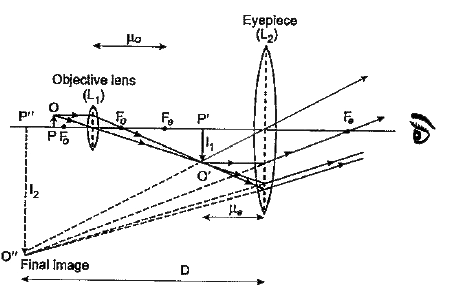Draw a schematic ray diagram of a compound microscope with the final image formed at infinity.
Similar Questions
Define the magnifying power of a compound microscope when the final image is formed at infinity. Why must both the objective and the eyepiece of a compound microscope have short focal lengths ? Explain.
View SolutionDraw a labelled ray diagram of an image formed by a compound microscope with final image formed at the least distance of distinct vision (D). Derive an expression for its magnifying power (in terms of V0,U0,fc and D).
View SolutionIn a compound microscope, the intermediate image is
View SolutionDraw a labelled ray diagram of an image formed by a refracting telescope with final image formed at infinity. Derive an expression for its magnifying power with the final image at infinity
View SolutionDraw a schematic ray diagram of a compound microscope with the final image formed at infinity.
View SolutionIn Gallilean telescope, the final image formed is
View Solution(i) Draw a neat labelled ray diagram of a compound microscope . Explain briefly its working .
(ii) Why must both the objective and the eye-piece of a compound microscope have short focal lengths ?
View SolutionA compound microscope uses an objective lens of focal length 4cm and eye lens of focal length 10cm. An object is placed at 6cm from the objective lens. Calculate magnifying power of compound microscope if final image is formed at the near point. Also, calculate length of the tube of compound microscope.
View SolutionIn a simple microscope, if the final image is located at infinity then its magnifying power is
View SolutionFind the distance between the two lenses of a compound microscope if the final image formed by the microscope is virtual and lies at a distance of 25cm to the left of the eye- piece. Magnifying power of the microscope is 30 and focal lengths of objective and eyepiece are 2cm and 5cm, respectively.
View Solution

